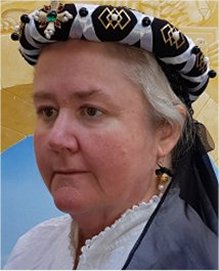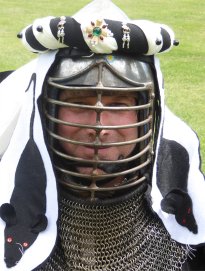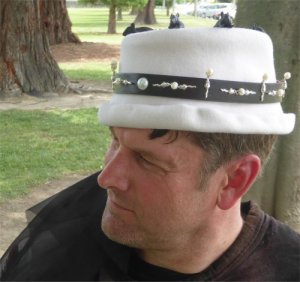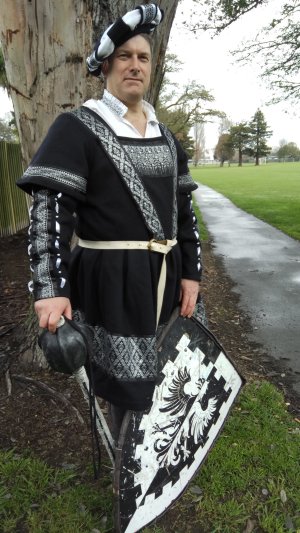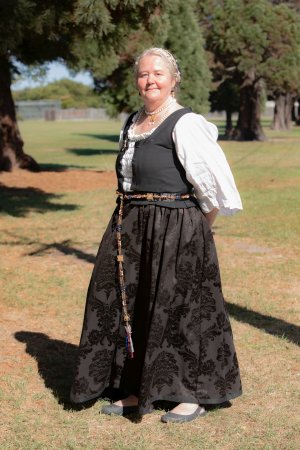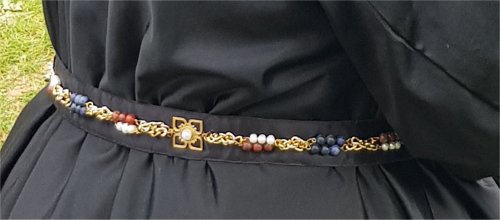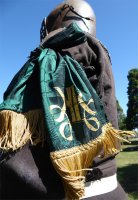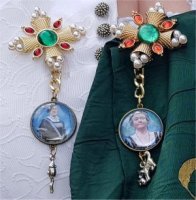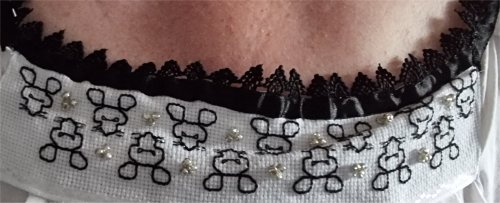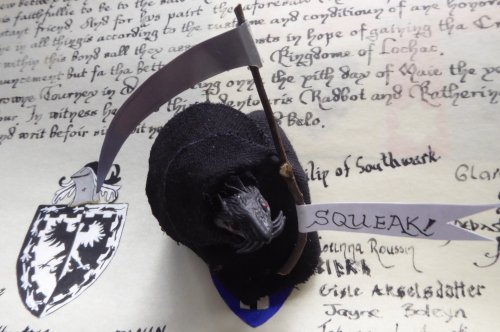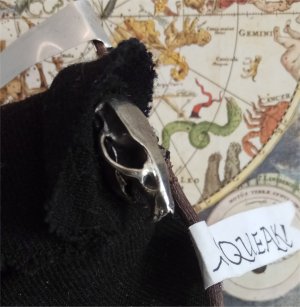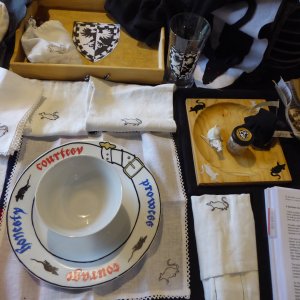 |
|
Consorting Garb for Radbot and katherineHeadware, Torse and Lambrequin, Coronet and Chapeau, Lederwams, Wappenrock and Hats
[Crown - A Rat and a Cat Consort]
[Consort Correspondence]
[Rat Heraldry]
When I began consorting with Sir Radbot I told him in no uncertain terms that I was not a garb Laurel, but... HeadwareGubbins Entry 2 cited With silken coats, and caps, and golden rings, with ruffs, and cuffs, and farthingales, and things for a garment to be worn. I'm not a great one for making garb, but I managed to find something to fit this challenge both for my persona and as Sir Radbot's consort. My mother Caterina Mocenigo was from a well-regarded Venetian family, and her wedding cassone houses a number of lovely items once hers. She wore this headware in honour of the Queen of Cyprus, whose funeral procession was one of the largest ever seen in La Serenissima. I had wanted to make a small head roll and veil for some time, but I wasn't inspired until I saw a Bellini painting (ca 1500) of Caterina Cornaro, Queen of Cyprus. Rather than a plain roll, Caterina sports a black, white and gold one, variously described as brocade or embroidered. The roll is securely shoved down over a closely fitted cap made up of what looks to me like alternating bands of lace, or possibly lacis in net. (Partridge, in the Art of Renaissance Venice, pg 96, describes it as damask.) A coronet crowns the whole ensemble. Underneath are two very fine gossamer black veils. I liked the idea of a decorated roll, and of multiple parts to the headwear allowing different looks. Another painting of Caterina appears to show a similar roll (or possibly a cap?) worn much further back on her head with a different veil beneath. (One thing I learned when researching this was the assertion that women wore their ears covered by veils to maintain chastity, this being the route the Holy Ghost took to impregnate the Blessed Virgin Mary!) My head roll is in Sir Radbot's colours, being part of my consort ensemble. The roll bears one of our favour pins and is decorated with various findings and freshwater pearls. The accompanying veil is silk chiffon, chosen for its sheerness and drape. The edges were stabilised with starch; Master William de Wyk demonstrated how to extract starch from a heavily kneaded flour and water dough. Ironing a starch-dampened edge onto brown paper made it a lot easier to cut a straight line and to press a fold into this uncooperative fabric.
The black ribbon and pearl earrings are modelled off the ones worn by the Lady with Squirrel by Montemezzano. At May Crown LIV, I added to my collection with a lovely pearl-based necklace and earrings, a consort gift provided by the Darton event steward. Classy! Torse and LambrequinFrom this roll, I went on to make a matching one, or rather a torse with associated mantling, to match the item for martial activities that was Gubbins 10 Is this a dagger I see before me?. I felt it my duty to help my consort present a good-looking corpse..er..combatant on the Field of Mars and so decided to make him a torse and matching lambrequin to adorn his helm and make it easier to identify him, alive or dead. The torse and mantling are commonly depicted in heraldic illustrations, the torse being a twisted roll of fabric holding the billowing drapery of the lambrequin or mantling. German Wappenbuchs (rolls of arms) show the use of torse and mantling in heraldry; illustrated manuscripts such as the Nuremberg Tournament and Parade Album show knights riding into tournaments with torse, mantling and crests. Both torse and mantling reflect Sir Radbot's livery colours of argent and sable, with references to his rat charges in the form of a number of small metal rat charms on the torse and rat dagging on the mantling. The torse is a general match to my own consort head roll, and has a long tail of silk, as seen in the Schembert Carnivals. Coronet and Chapeau
When Sir Radbot was made a Court Baron at Midwinter Coronation, I figured I could make him a modest wee coronet as a Christmas gift. So a batchload of metal rat charms, six large freshwater pearls and assorted smaller ones, and one black leather belt later...I've been told it's a bit pretty, but he has been seen wearing it, so maybe that's OK. I had been pouring over the Schembert Carnival paintings, speculating on the possibility of talking Radbot into considering a garb upgrade. I was a tad intimidated by the thought of constructing some very form-fitting onesies (no, really, take a look here!). But I figured I could manage one of the hats. I was helped out by a hat blank and borrowed milliner's gear from our talented hatter Margriet van Middelburg and the hard work of Vigdis Svínahildardóttir, who pummelled the thing into shape over the better part of a day. And, of course, more rats had to be added, this time in the form of a rat king peering over the top edge (a rat king being a bunch of rats whose tails have moulded together, possibly apocryphal though there are period references). These rats have their joined tails securely fastened with a shield bearing Sir Radbot's arms. The thing looks quite natty, if I say so myself. LederwamsFor a number of (apparently mostly random) reasons, Sir Radbot is vaguely lateish period German, so I started taking a look at things like the Schembert/Schembart Carnival costumes and Landsknecht items.
The Landsknecht lederwams caught my eye -- a form of wrapped leather vest, patterned by draping on the subject; I figured I could manage that! As it so happened I had some large pieces of black soft upholstery leather that had been fermenting in the fabric stash for a decade or so...Thus ensued much poring over a very helpful website, fiddling with a calico toile, pinnage, sewing, repinnage, actual cutting of leather and then some modest slashing. Given sewing is really not my thing, I was quite pleased with how it looked, specially with the addition of Master William de Cameron's custom-aigletted leather lace. (I just have to make sure Radbot doesn't stand next to the splendiferous slashed leather vests worn by Master Nicodemus and His Excellency Grim!) Wappenrock and Hats
The next item of garb was to be a Landsknecht wappenrock, more casually termed a "man-dress". There were plenty of examples of these in various woodcuts and lots of handy websites with useful information, but it was still waay out of my comfort zone. There was much work for the little grey cells, and advice from Mistress Rowan, examples from Sir Sebastian and practical assistance from Mistress Ginevra got me through multiple stages of planning, patterning and pinning. The test calico had all sorts of hieroglyphics and Frankensteinian additions by the time we were done. I'd had five metres of nice black wool waiting some decades for a suitable project, and had bought a length of cloth of silver for trim in Thailand, so it was just a matter of taking up the scissors and having at it... The trim frayed if looked at, so I zig-zagged the edges then hand-sewed metre after metre of black satin ribbon along all the edges. Careful alignment meant that the trim down the bib edge aligned nicely with the trim behind it, yes! The width of the trim around the hem, and its unwillingness to bend, meant sewing the trim in place then making adjustments at the waist to level it (I like that approach). After a couple of outings, the trim stated to fray, so I used up some of the very many metres of black velvet ribbon I had in stock, stamped 70+ rats around it and sewed it all thoroughly in place to catch the edges. I can't see any way he can pull it now, but we shall see. I had some wool left over so I made a set of tie-in Tudor sleeves for me, but then adapted those for Sir Ratbot instead (we apparently have the same arm length!). He was keen on slashing so I took to the wool and then ran some white ribbon through the cuts, fixing it in place with a bead. The idea was to have the right look without too much chance of snaggage. The sleeves are pretty warm so I made a second summer set based on the fancy black-and-silver ones of Francis I of France. I made up white satin backing for the black-and silver trim, then caught them up with black and silver ouches. I think they really hit the mark. There are also freshwater pearls across the front of the bib and a tiny rat charm on each shoulder, one black and one white (you might think they represent the good and bad angels of conscience, but I couldn't possibly comment). My original plan was to have this ready for May Crown, set to be in the cool Blue Mountains; it being 2020 that was not to be, but I did finally get to see it at our local Gildenwick event in September. As I'd hoped, the silver really did sparkle nicely in the candlelight.
Hats, Hats!More left-over wool suggested a hat or two...I based one (seen right) on the "starfish" hat worn by German mercenaries. The main defining feature seems to be the loops of material forming the brim. I've read that the padded roll fed through these loops acted as a rest for one's helmet. Radbot's starfish hat has more of the silver trim; the padded roll is made from brocade left over from a white doublet I made years ago. The other hat is more of a berret (I think), less flamboyant than the popular tallerberret with its masses of feathers, but a step up from a standard flat cap. These typically had cuts or slashes to show fancy materials beneath. In this case I made the cuts in the shape of the rat daggings I'd done for his lambrequin, and used a scrap of my white brocade as a liner. The centrepiece is one of the jewellery findings I have used in my tourney girdle. Refs: Garb for katherine
I figured it was my duty as a dutiful consort to differentiate katherine, the consort, so began to work on some suitable livery to match Sir Radbot's. Fortunately there was quite a bit of black and white material in my fabric pile for me to dither over. Lucky for me, while angsting about it, the lovely Ginevra gave me a beautiful warm black loose gown, just the thing for a late autumn in Darton. I ended up staying in it for most of the event, though for the tourney I added my rat-embellished skirt for some extra warmth and amusement. Later, I researched a new bodice and settled on one of those partially closed Italian tabbed jobs; I thought it might be easier to make. I used some salvaged lacing strips and stored fabric to produce something like a 1520s Venetian look (eg Palma Vecchio's Woman in Blue). The sleeveless bodice is black linen lined with green taffeta, deliberately double-sided for twice the utility; I have a number of black or white sleeves that can be attached. A black skirt made from 2m of bargain box brocade brought back from Venice was kindly pleated by Ginevra, and completes my main tourney outfit in Radbot's colours. Tourney GirdleTo hold the loose gown together, I made a girdle, utilising the colours on my arms with triple groupings of beads of jasper (red), sodalite (blue) and freshwater pearls (white), strung on chain and separated by some ancient quatrefoil findings I had. I made them up to be useful, when separated out, as chaplets, and then combined the lot, twisted them to adjust the length (mostly right) and sewed them to a broad black satin ribbon casing a sturdy webbing for strength.
At the Crown Tourney's closing court (ASLIV), we presented a chaplet each to the new Crown Prince and Princess, noting that the beads represented the red lands of Terra Rosa, the white clouds and snows of the Crescent Isles, bound together by the blue skies and waters that joined us as one Kingdom.
Since then I have endeavoured to wear the girdle whenever I attend upon Sir Radbot at tourney. Tourney Favour and MiniaturesSir Radbot, likewise, carries my favour in the lists. The favour is in the form of a length of green taffeta -- known in certain parts as "katherine green" -- with gold fringing at the ends. The fabric bears a gold-painted kk sigil, with embellishments and, on formal occasions, can be fixed in placed with one of our fancy favour pins. Am I evil to have been pleased and amused at one tournament when my knight confessed he had forgotten his white belt but had remembered my favour...
I did have the hubris to make a miniature of myself to attach to the pin, along with a parti-coloured eagle charm (which promptly fell off on the tourney field in its first outing). This references the one sent to Radbot as part of the ransom negotiations during the Baskin-Kerr alternative timeline adventures in the Caribbean. I've also made a matching miniature of him for me to wear when he fights -- seems a safer option! Formal Documentation on Pictures in LittleThe goldsmith and limner Nicholas Hilliard and his protégé Isaac Oliver were the leading exponents of the art of miniature portraiture in the later Elizabethan period from the 1570s to the early 1600s. At the turn of the century, Hilliard wrote a somewhat rambling Treatise on the subject covering everything from painting tips to minor rants, praise for Albert Durer to name-dropping Her Majesty. Over roughly 40 years, the two men captured the likenesses of sovereigns, courtiers and wealthy merchants, men, women and some children – the 2019 exhibition of their work at the National Portrait Gallery (London) showed over 90 examples; there are 3,000+ in the Royal Collection. The technique, and the very personal adornment produced, saw Elizabethans called this “the perfection of art” (Faraday). These highly detailed works typically measured 30-60 mm in diameter, were framed in gold or held in lockets, with rings at the top to allow chains or ribbons so they could be worn close to the heart, held in the hand or pinned to the chest. (See left-hand period example, in accompanying page, of Hilliard’s Unknown Man Against Love’s Flames.) We call these works “miniatures”; Elizabethans termed them “pictures in little” or limnings. Some were as large as 250 mm, often oval to fit a longer view of the body or landscape setting, and, rather than used as jewellery, came to be known as “cabinet” miniatures for their display in cabinet collections. Pictures in little were typically painted in gouache or watercolour, occasionally oils, on polished vellum laid onto light pasteboard. Hilliard often used playing cards as a convenient source of the latter; appropriately enough one flattering miniature of Queen Elizabeth is painted upon a Queen of Hearts. They ranged from head-and-shoulders to full-length portraits – a tasking job at such a small size – often against a plain blue ground with gold lettering such as initials, names or dates relating to the subject, or sometimes simply gold diapering. When I contracted to consort with Sir Ratbot, amongst the various items I set out to make for him was a limning of me. After all, one of the intentions of a miniature was to assure a friend of one’s support (Faraday). They also have strong associations with affection and loyalty, and were relatively common as gifts. Marie, Countess of Champagne, includes a picture as one of the acceptable gifts in the list the 12th-century author Andreas Cappelanus cites in De Arte Honesti Amande, a work which heavily influenced notions of chivalric relationships for 400 years. A local $2 shop provided a reasonably suitable mount with a clear domed glass cover, albeit a tad small at 26mm in diameter. It looked comparable to some miniatures I had seen in the National Portrait Gallery (Scotland), which had paintings protected by a curved covering of polished rock crystal. That became the physical case to hold the portraits, each attached to one of our favour pins by a short length of chain from my tourney girdle, low-quality metal but meaningful. Each miniature has a small metal charm – a rat on one and a cat carrying a rat in its mouth on the other, representing my lord-consort and me respectively. As I lack the skill, dexterity, patience and eyesight of Messers Hilliard and Oliver – I found out afterwards that Gordon Harris does, in fact, stock the tiny squirrel-hair brushes such as they used! – I resorted to using photographic portraits. It at least allows, as Hilliard put it, the ability to catch those lovely graces, witty smilings, and those stolen glances which suddenly like lightning pass. In some senses, a photo is the modern equivalent to the fast nature of the miniature portrait painting session where the artist would take 2-3 quick sittings to directly paint the face, sometimes on to a prepped face blank, to produce a “lively” image of the sitter (Hilliard’s Treatise). The cut-out images were given a ground of a gold-diapered blue as per common practice. If I was to do this again, I would try some of Hilliard’s tricks of highlighting the gold and silver on the clothing with suitable paint or gold leaf to make it catch the eye more – preferably with a bigger case to work with! And maybe use the Aces of Spades (for Ratbot’s) and Hearts (mine) as backing; cards proved a tad chunky for the small casing this time round. Sir Ratbot’s portrait shows him in the clothing I made for him in his heraldic colours of sable and argent, wearing the white belt of a knight; mine shows me wearing my baronial coronet. Symbols of rank and heraldic imprese references were common motifs in such items of personal jewellery. The National Portrait Gallery (London, 2019) exhibition noted the late appearance of a circular miniature of Lady Mary Sidney, suggesting that the unusual shape for the late-1580s item may have been because it was to be matched to an earlier piece, so it appears there is precedence for having a pair of related limnings, in addition to circular portraits instead of the more common oval shape. On the back, each miniature bears a second image – that of our respective spouses, such that we can each declare that they, in fact, lie closest to our hearts. That’s not something I’ve seen in any extant miniature per se, but the conceit – and the delight in hidden meanings – fits well with many jewellery motifs from the period eg secret inscriptions on the inside of rings or Hilliard’s Heneage/Armada Jewel. I have made a number of various period-based items of jewellery over the years but this pair of miniatures, despite their very simple nature, has been amongst the most pleasing. This project has made me appreciate how a variety of very basic jewellery findings, courtesy of a $2 shop and AliExpress, can be brought together to make something that is more meaningful than the sum of its parts, and help enhance our persona play more than the usual adornment. For my part I have found that the miniature I wear of Sir Ratbot often catches the eye of others and acts as a good conversation opener with a much broader story to tell than that of any fancy gem-encrusted perfect period-replica piece of jewellery. Rat Chemise and SleevesI revamped an old chemise with a neckline of blackwork rattage with silvery whiskers and some beading and lace, and made myself a pair of sleeves to closely match the Francis I versions I had made for my consort.
Rat StuffDeath of Rats, Tray and Tableware, Ratbags and other Embroidered Items Death of RatsIn the run-up to May Crown ASLIV, I began collecting a variety of rat-based items: charms, stickers, silhouettes, rubbery beasties and the like. The latter came in black, white and grey, and were duly distributed around the food table at the event. But I reserved one of the black ones to make a little Death of Rats, complete with scythe, gown and full-caps SQUEAK!.
If you don't recognise the reference to Discworld's Grim Squeaker, explanation here. Oddly enough most SCAdians have recognised him straight off, but not one has commented that he is full-bodied, rather than skeletal. Sadly, there was a distinct lack of rat skeletons at the Halloween sales (though there were spider skeletons? really???). I did pick up a skeletal cat lawn ornament, which has had the occasional outing with the Death of Rats sitting on top -- medieval cat-and-rat marginalia includes images of rats riding cats, sometimes "hawking" with a snail held aloft on an up-raised paw. I deployed the Death of Rats after our first May Crown Tournament and, when at the Feast, made the mistake of sitting him in front of the new Crown Prince (yes, the one who'd killed Ratbot in the finals). His Highness scooped the Death of Rats up with a triumphant "I'm taking this home!". Oh well, it was nice it was appreciated. Death of Rats #2 has since made an appearance, now with a built-in brooch pin so he can ride securely on my shoulder. SNH SNH SNH!
Death of Rats #3 The fine people at Fire & Bone take 3D scans of real animal skulls -- eagles, sabre-tooth tigers, wolves, you name it! -- and use a scaled-down 3D-printed model for a lost-wax cast in bronze or silver. And yes, there was a Rattus norvegicus amongst the offerings, huzzah! Death of Rats #3 now looks much more authentic, though I confess to some qualms in having to cut #2's head off to make way for the upgrade.... Tray, Tableware and Ratbags (G7)
I have promised to be a generous consort to Sir Radbot von Borg and, on learning that he lacked suitable items to bring to table, I began work to rectify that. For the Baronial Heraldic Challenge I made a number of things marked with Sir Radbot's device or rat charge; For the Gubbins 7 Challenge, 'Fore God, you have here a goodly dwelling and a rich, I made a set of embroidered linens. The ratbag and ratkerchief goes with a feast kit set (a rat-marked market wallet, trencher, cutlery roll, bag and napkin) I presented to Sir Radbot at Coronation. The kerchief is of linen with a simple lace edging; the bag is linen with ties in his livery colours. All the linen work bears a simple embroidered rat outline as a charge from Sir Radbot's arms.
He also has a wooden tray bearing his arms, an arms-marked salt cellar with salt I made for the Variety Challenge (14/20), and a tourney glass (ie made of shockproof clear acrylic, perfect for chucking in the armour bag). The glass has his arms painted on in Italian style, along with a large initial R with tiny rats perched on the flourishes. I painted Sir Ratbot's four favourite virtues -- prowess, honesty, courage and courtesy -- on a white belt around the edge of a plate with matching ones on a bowl, along with obligatory rats.
| |||||||||||||||||||||||||||||||||||||||||||||||||||||||||||||||||
